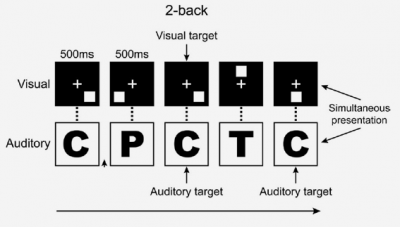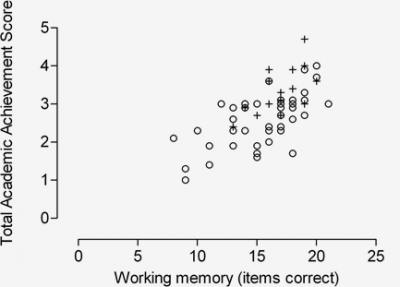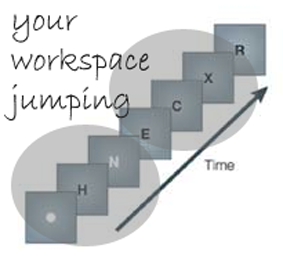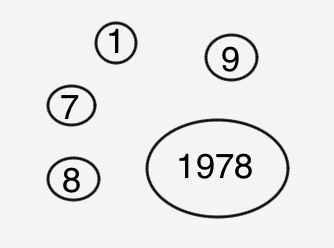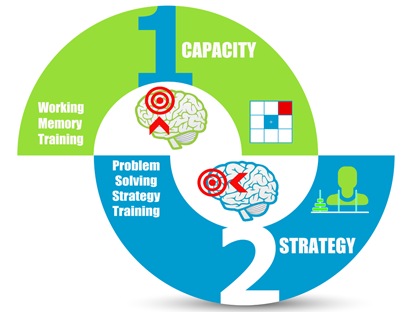The brain training method utilized by HighIQPro is called ‘capacity-strategy’ training, designed to increase intelligence and improve problem solving and decision-making skills. Here we review the capacity-strategy method.
Dual N-Back Training is highly effective, but it has limitations
One component of HighIQPro neuroplasticity brain training is working memory training, using a ‘second generation’ version of the dual n-back.
The aim of all WM training programs is to expand working memory capacity. The most widely studied brain training exercise targeting WM capacity is the dual n-back task. The N-back task involves viewing a continuous stream of items (e.g., letters) and deciding whether each item matches the stimulus presented n stimuli back. In dual n-back training, a verbal and a visuo-spatial stream of items is presented simultaneously and item matches have to be detected for both types of information. This dual task requires updating items in both the visual short term store and the verbal short term stores of working memory. The most well-known dual n-back task has been developed by Dr. Susanne Jaeggi and her colleagues back in 2007.
N-back training is known to improve the following cognitive functions:
Known benefits of n-back working memory training
WM capacity training has been shown in replicated studies to result in the following cognitive benefits (reviews: Morrison & Chein, 2011; Salminen, Strobach & Schubert, 2012):
- Increased performance on untrained measures of short term memory.
- Multi-tasking – i.e. attentional selection between two sets of information associated with different tasks.
- Detaching attention from irrelevant items and attending to new relevant items.
- Shielding against interfering information.
- Episodic memory.
- Reading comprehension.
- Verbal learning and every day attention in older adults (60+).
- Reduced symptoms of ADHD.
- Improvements for multiple sclerosis – everyday memory, quality of life.
- Improvements for schizophrenia patients – everyday memory, quality of life.
- Improvements for frontal lobe stroke patients.
In general terms, the larger your working memory capacity or ‘mental workspace’, the greater your capacity for higher order cognition and thus academic and professional achievement. An example of this relationship is shown below.
For my review of n-back working memory training effects on general cognitive performance, click on the pdf icon:
![]()
Limitations of dual n-back working memory training
There are clear benefits of working memory training for overall cognitive performance and brain health. However, there are also well-recognized weaknesses. One major weakness is maintained motivation to complete the 20 day course. The original Jaeggi task is deadly dull and only a small percentage of highly committed individuals generally complete the program from their own initiative.
The following are three n-back strategies people naturally use to maintain or go up n-back levels using the traditional Jaeggi n-back task. However, they disrupt the genuine expansion of working memory capacity – they are actually ways of compensating for limitations of working memory capacity to increase your n-back performance. It is as though you are making up for lack of physical strength when weight training by using different body movements that don’t actually help your strength movements.
Attentional blinking
As you get more experienced with the HighIQPro dual n-back task, it is possible to strategically direct your attention in ‘jumps’ to useful strings of letters or square locations in order to maintain or go up an n-back level. Using this strategy, you are not actually updating the items in your working memory continuously, but are ‘counting through’ a particular string of items and then refreshing it from the start again for the next string. This is a kind of attentional blink.
Chunking
Sometimes during the dual n-back task, a letter or location may be repeated one two or even three times. When this happens it is easier perform on the n-back exercise because with only one ‘place holder’ there is less information to ‘encode’ to do the task. Or at other times, there may be a meaningful string of letters that forms a word or acronym, or the sequence of locations forms a known shape. When items can be grouped together like this, easing the burden on our memory system, this is called ‘chunking’. Chunking can also benefit from practice.
Playing the odds
Another strategy that is used during standard n-back tasks is playing the odds. This involves having a rough idea that an item was e.g. to the left or right, and taking systematic guesses as to the exact location. Instead of remembering exact locations and letter identities, this strategy can help a player maintain an n-back level or go up a level based on statistical ‘bets’.
These three n-back strategies are actually ways of getting around (i.e. compensating for) limitations of working memory capacity to increase your n-back performance. But getting practice with these strategies doesn’t actually help increase working memory capacity itself.
HighIQPro ‘second generation’ dual n-back training
The HighIQPro working memory task differs from other dual n-back versions, addressing some of the weaknesses in the following ways:
- For motivation, HighIQPro incorporates ‘game-like’ incentives, such as reward sounds, and ‘best score’ tables in case the user wants to compare his/her performance with other users. Score comparisons can be revealed after each session of training, as well as for the overall n-back attained.
- HighIQPro offers a ‘fast’ setting, in which stimulus presentations are double the rate. This helps with motivation in that only half the training time is needed to complete the session. It also trains processing speed.
- HighIQPro helps prevent attentional chunking by having both letter and number options for the stimuli. Users can experiment with the modality that affords the least chunking.
- HighIQPro largely prevents attentional blinking and playing the odds strategies by having a ‘hard task’ setting which puts a stricter criterion on players t maintain and increase their n-back level. It is much harder to use these strategies on this harder setting, forcing users to genuinely expand their working memory capacity to go up an n-back level.
Capacity-strategy training
It is well established in the cognitive science literature that a larger working memory capacity functions to allow for easier utilization and memorization of rules , strategies or procedures – whether for learning, solving problems, making decisions and skill-acquisition. To learn how to do a mathematical calculation, you need to learn mathematical rules; to learn how to drive a car, you need to learn how to operate the car with certain operations; to learn a second language, you need to apply grammatical rules.
Working memory circuitry is located in the dorsolateral prefrontal cortex. Activation in this area allows for the flexible application of a wider range of novel strategies and rules, overcoming automatic responses, and these new rules – with practice – are then more effectively encoded in more anterior (to the front of the head) prefrontal areas. This is shown in the ‘Capacity-Strategy’ infographic above, and this is precisely the kind of training method HighIQPro utilizes.
In addition to second generation n-back training that expands working memory capacity, HighIQPro builds in problems / brain teasers with associated online ‘mindware’ tutorials to allow for fast, efficient learning of strategies for problem solving and decision-making. Both approaches – capacity & strategy – work synergistically.
References
Alloway, T. P., Gathercole, S. E., Willis, C., & Adams, A.-M. (2004). A structural analysis of working memory and related cognitive skills in young children. Journal of Experimental Child Psychology, 87(2), 85–106. doi:10.1016/j.jecp.2003.10.002
Baddeley, A. (2000). The episodic buffer: a new component of working memory? Trends in Cognitive Sciences, 4(11), 417–423. doi:10.1016/S1364-6613(00)01538-2
Baddeley, A. (2003). Working memory and language: an overview. ASHA 2002, 36(3), 189–208. doi:10.1016/S0021-9924(03)00019-4
Baddeley, A., & Hitch, G. (1974). Working memory. In G. H. Bower (Ed.), The psychology of learning and motivation: Advances in research and theory (Vol. 8) (pp. 47–89). New York: Academic Press.
Chein, J., & Morrison, A. (2010). Expanding the mind’s workspace: Training and transfer effects with a complex working memory span task. Psychonomic Bulletin & Review, 17(2), 193–199. doi:10.3758/PBR.17.2.193
Cowan, N., Elliott, E., Scott Saults, J., Morey, C., Mattox, S., Hismjatullina, A., & Conway, A. (2005). On the capacity of attention: its estimation and its role in working memory and cognitive aptitudes. Cognitive psychology, 51(1), 42–100.
Daneman, M., & Carpenter, P. A. (1980). Individual differences in working memory and reading. Journal of Verbal Learning and Verbal Behavior, 19(4), 450–466. doi:10.1016/S0022-5371(80)90312-6=
Engle, R. W., Tuholski, S. W., Laughlin, J. E., & Conway, A. R. A. (1999). Working memory, short-term memory, and general fluid intelligence: A latent-variable approach. Journal of Experimental Psychology: General, 128(3), 309–331. doi:10.1037/0096-3445.128.3.309
Ericsson, K. A., & Chase, W. G. (1982). Exceptional memory. American Scientist, 70, 607-615.
Fukuda, K., & Vogel, E. K. (2009). Human Variation in Overriding Attentional Capture. The Journal ofNeuroscience, 29(27), 8726–8733. doi:10.1523/JNEUROSCI.2145-09.2009
Fukuda, K., & Vogel, E. K. (2011). Individual Differences in Recovery Time From Attentional Capture. Psychological Science, 22(3), 361–368. doi:10.1177/0956797611398493
Gray, J.R., Chabris, C.F., and Braver, T.S. (2003). Neural mechanisms of general fluid intelligence. Nature Neuroscience, 6, 316-322.
Green, C. S., & Bavelier, D. (2008). Exercising your brain: A review of human brain plasticity and training-induced learning. Psychology and Aging, 23(4), 692–701. doi:10.1037/a0014345
Kane, M. J., Hambrick, D. Z., Tuholski, S. W., Wilhelm, O., Payne, T. W., & Engle, R. W. (2004). The Generality of Working Memory Capacity: A Latent-Variable Approach to Verbal and Visuospatial Memory Span and Reasoning. Journal of Experimental Psychology: General, 133(2), 189–217. doi:10.1037/0096-3445.133.2.189
Klingberg, T., Fernell, E., Olesen, P. J., Johnson, M., Gustafsson, P., Dahlström, K., Gillberg, C. G., et al. (2005). Computerized Training of Working Memory in Children With ADHD-A Randomized, Controlled Trial. Journal of the American Academy of Child & Adolescent Psychiatry, 44(2), 177–186. doi:10.1097/00004583-200502000-00010
McNab, F., & Klingberg, T. (2008). Prefrontal cortex and basal ganglia control access to working memory. Nat Neurosci, 11(1), 103–107. doi:10.1038/nn2024
McVay, J. C., & Kane, M. J. (2009). Conducting the train of thought: Working memory capacity, goal neglect, and mind wandering in an executive-control task. Journal of Experimental Psychology: Learning, Memory, and Cognition, 35(1), 196–204. doi:10.1037/a0014104
Morrison, A. B., & Chein, J. M. (2011). Does working memory training work? The promise and challenges of enhancing cognition by training working memory. Psychonomic Bulletin & Review, 18(1), 46–60. doi:10.3758/s13423-010-0034-0
Salminen, T., Strobach, T., & Schubert, T. (2012). On the impacts of working memory training on executive functioning. Frontiers in Human Neuroscience, 6(166). doi:10.3389/fnhum.2012.00166
Smith, E. E., & Jonides, J. (1998). Neuroimaging analyses of human working memory. Proceedings of the National Academy of Sciences, 95(20), 12061–12068. doi:10.1073/pnas.95.20.12061
Tsuchida, Y., Katayama, J., & Murohashi, H. (2012). Working memory capacity affects the interference control of distractors at auditory gating. Neuroscience Letters, 516(1), 62–66. doi:10.1016/j.neulet.2012.03.057
Turley-Ames, K. J., & Whitfield, M. M. (2003). Strategy training and working memory task performance. Journal of Memory and Language, 49(4), 446–468. doi:10.1016/S0749-596X(03)00095-0
Wager, T.D., & Smith, E. E. (2003). Neuroimaging studies of working memory: A metaanalysis. Cognitive and Affective Behavioral Neuroscience, 3, 255–274.


